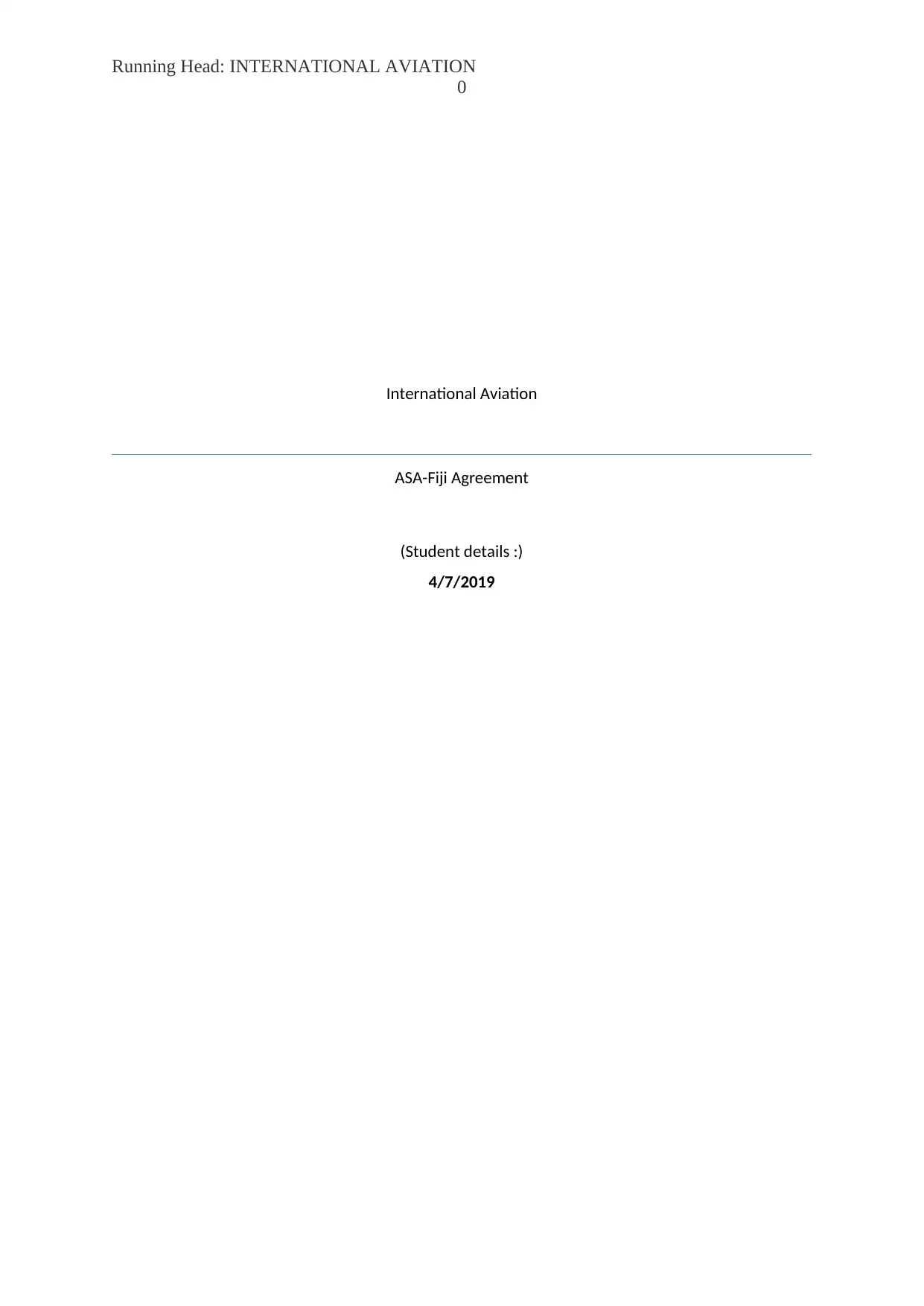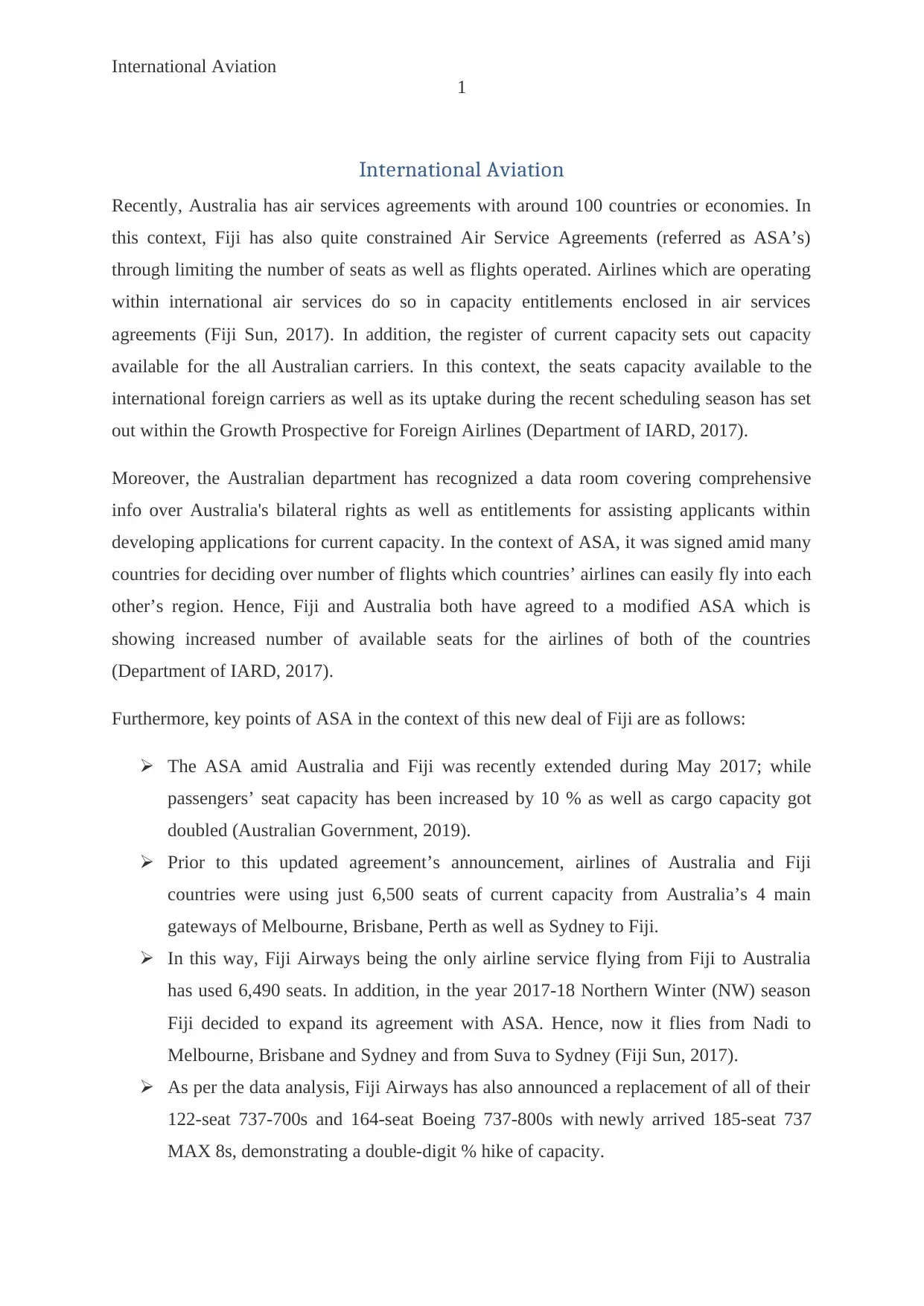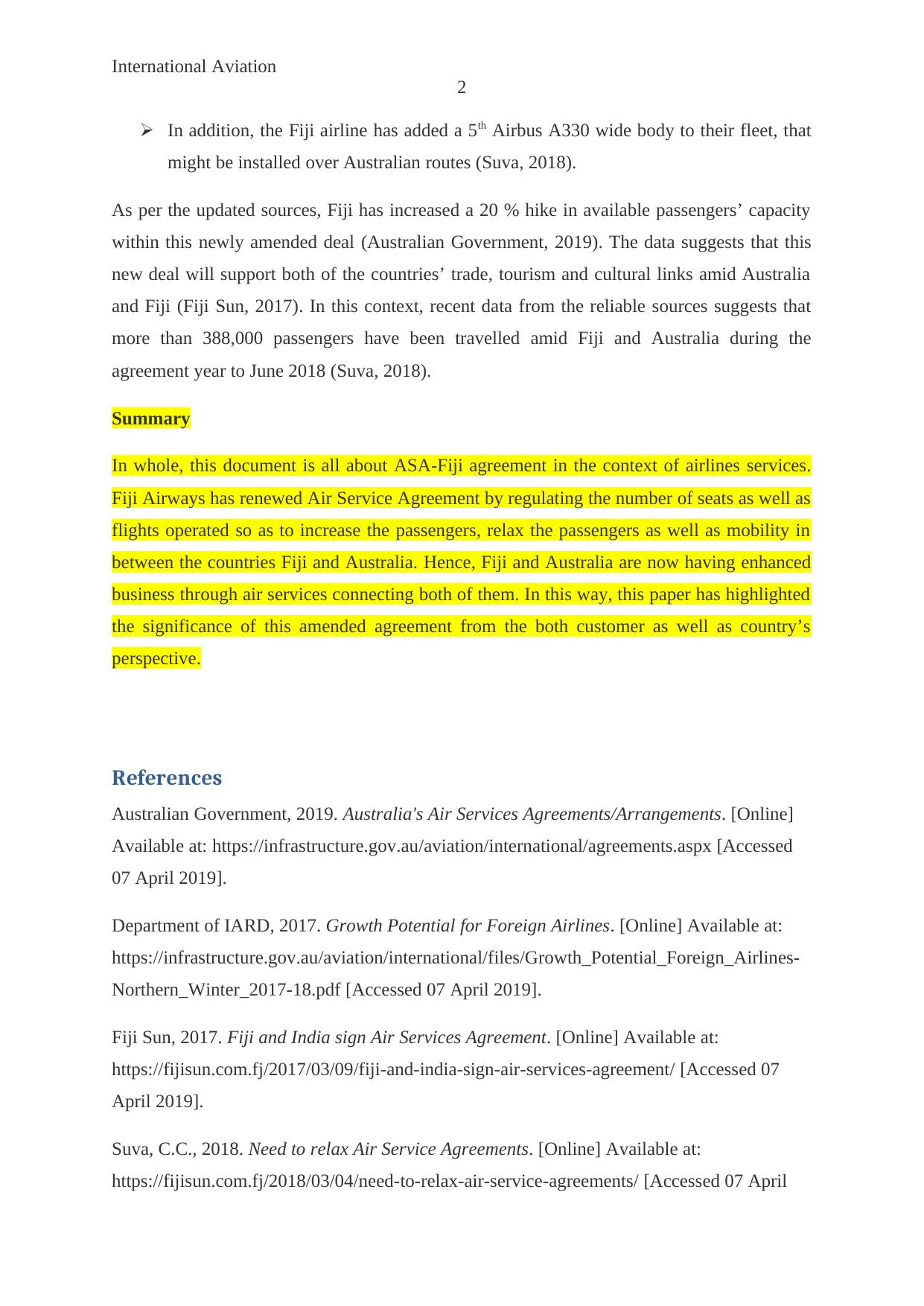Analysis of International Aviation ASA-Fiji Agreement and Key Points
VerifiedAdded on 2023/01/17
|4
|812
|49
Report
AI Summary
This document summarizes the ASA-Fiji agreement, focusing on the expansion of air services between Australia and Fiji. The agreement, extended in May 2017, increased passenger seat capacity by 10% and doubled cargo capacity. Fiji Airways, the primary airline, has expanded its operations, adding new aircraft and routes. Data analysis reveals a significant increase in passenger numbers between the two countries, supporting trade, tourism, and cultural links. The report highlights the significance of the amended agreement from both customer and country perspectives, showcasing the impact of increased capacity and improved air services.

Running Head: INTERNATIONAL AVIATION
0
International Aviation
ASA-Fiji Agreement
(Student details :)
4/7/2019
0
International Aviation
ASA-Fiji Agreement
(Student details :)
4/7/2019
Paraphrase This Document
Need a fresh take? Get an instant paraphrase of this document with our AI Paraphraser

International Aviation
1
International Aviation
Recently, Australia has air services agreements with around 100 countries or economies. In
this context, Fiji has also quite constrained Air Service Agreements (referred as ASA’s)
through limiting the number of seats as well as flights operated. Airlines which are operating
within international air services do so in capacity entitlements enclosed in air services
agreements (Fiji Sun, 2017). In addition, the register of current capacity sets out capacity
available for the all Australian carriers. In this context, the seats capacity available to the
international foreign carriers as well as its uptake during the recent scheduling season has set
out within the Growth Prospective for Foreign Airlines (Department of IARD, 2017).
Moreover, the Australian department has recognized a data room covering comprehensive
info over Australia's bilateral rights as well as entitlements for assisting applicants within
developing applications for current capacity. In the context of ASA, it was signed amid many
countries for deciding over number of flights which countries’ airlines can easily fly into each
other’s region. Hence, Fiji and Australia both have agreed to a modified ASA which is
showing increased number of available seats for the airlines of both of the countries
(Department of IARD, 2017).
Furthermore, key points of ASA in the context of this new deal of Fiji are as follows:
The ASA amid Australia and Fiji was recently extended during May 2017; while
passengers’ seat capacity has been increased by 10 % as well as cargo capacity got
doubled (Australian Government, 2019).
Prior to this updated agreement’s announcement, airlines of Australia and Fiji
countries were using just 6,500 seats of current capacity from Australia’s 4 main
gateways of Melbourne, Brisbane, Perth as well as Sydney to Fiji.
In this way, Fiji Airways being the only airline service flying from Fiji to Australia
has used 6,490 seats. In addition, in the year 2017-18 Northern Winter (NW) season
Fiji decided to expand its agreement with ASA. Hence, now it flies from Nadi to
Melbourne, Brisbane and Sydney and from Suva to Sydney (Fiji Sun, 2017).
As per the data analysis, Fiji Airways has also announced a replacement of all of their
122-seat 737-700s and 164-seat Boeing 737-800s with newly arrived 185-seat 737
MAX 8s, demonstrating a double-digit % hike of capacity.
1
International Aviation
Recently, Australia has air services agreements with around 100 countries or economies. In
this context, Fiji has also quite constrained Air Service Agreements (referred as ASA’s)
through limiting the number of seats as well as flights operated. Airlines which are operating
within international air services do so in capacity entitlements enclosed in air services
agreements (Fiji Sun, 2017). In addition, the register of current capacity sets out capacity
available for the all Australian carriers. In this context, the seats capacity available to the
international foreign carriers as well as its uptake during the recent scheduling season has set
out within the Growth Prospective for Foreign Airlines (Department of IARD, 2017).
Moreover, the Australian department has recognized a data room covering comprehensive
info over Australia's bilateral rights as well as entitlements for assisting applicants within
developing applications for current capacity. In the context of ASA, it was signed amid many
countries for deciding over number of flights which countries’ airlines can easily fly into each
other’s region. Hence, Fiji and Australia both have agreed to a modified ASA which is
showing increased number of available seats for the airlines of both of the countries
(Department of IARD, 2017).
Furthermore, key points of ASA in the context of this new deal of Fiji are as follows:
The ASA amid Australia and Fiji was recently extended during May 2017; while
passengers’ seat capacity has been increased by 10 % as well as cargo capacity got
doubled (Australian Government, 2019).
Prior to this updated agreement’s announcement, airlines of Australia and Fiji
countries were using just 6,500 seats of current capacity from Australia’s 4 main
gateways of Melbourne, Brisbane, Perth as well as Sydney to Fiji.
In this way, Fiji Airways being the only airline service flying from Fiji to Australia
has used 6,490 seats. In addition, in the year 2017-18 Northern Winter (NW) season
Fiji decided to expand its agreement with ASA. Hence, now it flies from Nadi to
Melbourne, Brisbane and Sydney and from Suva to Sydney (Fiji Sun, 2017).
As per the data analysis, Fiji Airways has also announced a replacement of all of their
122-seat 737-700s and 164-seat Boeing 737-800s with newly arrived 185-seat 737
MAX 8s, demonstrating a double-digit % hike of capacity.

International Aviation
2
In addition, the Fiji airline has added a 5th Airbus A330 wide body to their fleet, that
might be installed over Australian routes (Suva, 2018).
As per the updated sources, Fiji has increased a 20 % hike in available passengers’ capacity
within this newly amended deal (Australian Government, 2019). The data suggests that this
new deal will support both of the countries’ trade, tourism and cultural links amid Australia
and Fiji (Fiji Sun, 2017). In this context, recent data from the reliable sources suggests that
more than 388,000 passengers have been travelled amid Fiji and Australia during the
agreement year to June 2018 (Suva, 2018).
Summary
In whole, this document is all about ASA-Fiji agreement in the context of airlines services.
Fiji Airways has renewed Air Service Agreement by regulating the number of seats as well as
flights operated so as to increase the passengers, relax the passengers as well as mobility in
between the countries Fiji and Australia. Hence, Fiji and Australia are now having enhanced
business through air services connecting both of them. In this way, this paper has highlighted
the significance of this amended agreement from the both customer as well as country’s
perspective.
References
Australian Government, 2019. Australia's Air Services Agreements/Arrangements. [Online]
Available at: https://infrastructure.gov.au/aviation/international/agreements.aspx [Accessed
07 April 2019].
Department of IARD, 2017. Growth Potential for Foreign Airlines. [Online] Available at:
https://infrastructure.gov.au/aviation/international/files/Growth_Potential_Foreign_Airlines-
Northern_Winter_2017-18.pdf [Accessed 07 April 2019].
Fiji Sun, 2017. Fiji and India sign Air Services Agreement. [Online] Available at:
https://fijisun.com.fj/2017/03/09/fiji-and-india-sign-air-services-agreement/ [Accessed 07
April 2019].
Suva, C.C., 2018. Need to relax Air Service Agreements. [Online] Available at:
https://fijisun.com.fj/2018/03/04/need-to-relax-air-service-agreements/ [Accessed 07 April
2
In addition, the Fiji airline has added a 5th Airbus A330 wide body to their fleet, that
might be installed over Australian routes (Suva, 2018).
As per the updated sources, Fiji has increased a 20 % hike in available passengers’ capacity
within this newly amended deal (Australian Government, 2019). The data suggests that this
new deal will support both of the countries’ trade, tourism and cultural links amid Australia
and Fiji (Fiji Sun, 2017). In this context, recent data from the reliable sources suggests that
more than 388,000 passengers have been travelled amid Fiji and Australia during the
agreement year to June 2018 (Suva, 2018).
Summary
In whole, this document is all about ASA-Fiji agreement in the context of airlines services.
Fiji Airways has renewed Air Service Agreement by regulating the number of seats as well as
flights operated so as to increase the passengers, relax the passengers as well as mobility in
between the countries Fiji and Australia. Hence, Fiji and Australia are now having enhanced
business through air services connecting both of them. In this way, this paper has highlighted
the significance of this amended agreement from the both customer as well as country’s
perspective.
References
Australian Government, 2019. Australia's Air Services Agreements/Arrangements. [Online]
Available at: https://infrastructure.gov.au/aviation/international/agreements.aspx [Accessed
07 April 2019].
Department of IARD, 2017. Growth Potential for Foreign Airlines. [Online] Available at:
https://infrastructure.gov.au/aviation/international/files/Growth_Potential_Foreign_Airlines-
Northern_Winter_2017-18.pdf [Accessed 07 April 2019].
Fiji Sun, 2017. Fiji and India sign Air Services Agreement. [Online] Available at:
https://fijisun.com.fj/2017/03/09/fiji-and-india-sign-air-services-agreement/ [Accessed 07
April 2019].
Suva, C.C., 2018. Need to relax Air Service Agreements. [Online] Available at:
https://fijisun.com.fj/2018/03/04/need-to-relax-air-service-agreements/ [Accessed 07 April
⊘ This is a preview!⊘
Do you want full access?
Subscribe today to unlock all pages.

Trusted by 1+ million students worldwide

International Aviation
3
2019].
3
2019].
1 out of 4
Related Documents
Your All-in-One AI-Powered Toolkit for Academic Success.
+13062052269
info@desklib.com
Available 24*7 on WhatsApp / Email
![[object Object]](/_next/static/media/star-bottom.7253800d.svg)
Unlock your academic potential
Copyright © 2020–2025 A2Z Services. All Rights Reserved. Developed and managed by ZUCOL.



